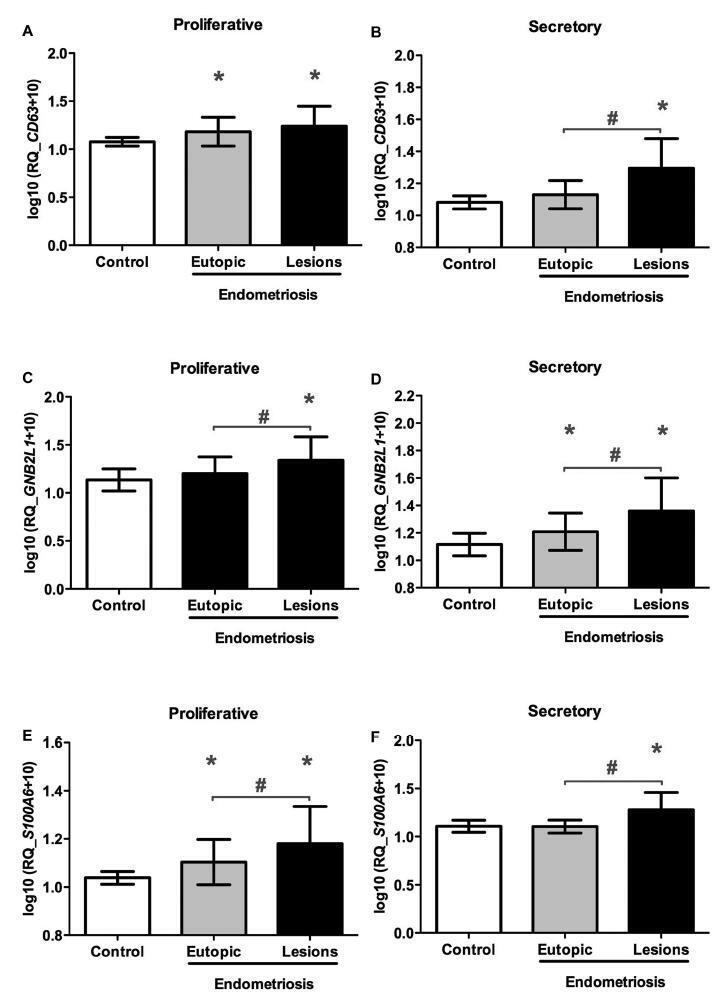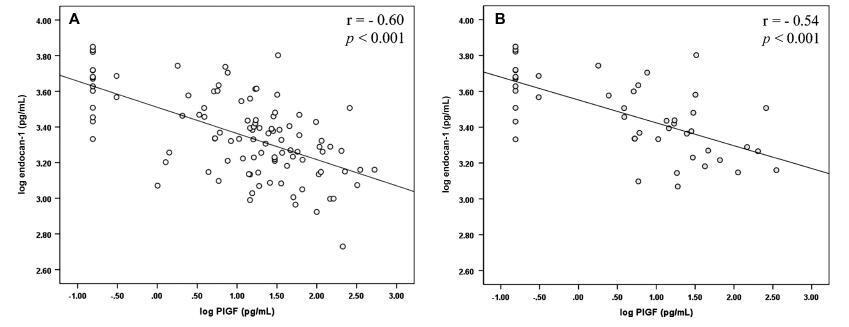Summary
Revista Brasileira de Ginecologia e Obstetrícia. 2018;40(12):733-739
To determine the role of caspase-3, apoptosis-inducing factor (AIF), and Bcell lymphoma-2 (Bcl-2) expressions in term premature rupture of membrane (PROM).
An analytic observational study with case-control design was conducted, involving 52 subjects (37-42 weeks of gestation) who were divided into 2 groups: 26 cases of term delivery with PROM, and 26 controls of term delivery without PROM. The expressions of caspase-3, AIF, and Bcl-2 in the amniotic membrane were determined by immunohistochemistry. Data were analyzed using the chi-squared test. The risk of PROM was expressed by odds ratio (OR).
There were no significant differences in age, parity and body mass index between the two groups (p > 0.05). High caspase-3 and AIF expressions increased the risk of PROM 17.64 times (OR = 17.64; 95% CI = 4.44-70.07; p = 0.001) and 9.45 times (OR = 9.45; 95% CI= 2.62-34.07; p = 0.001), respectively, while low Bcl-2 expression increased 10.39 times (OR = 10.39; 95% CI = 2.73-39.56; p = 0.001)the risk of PROM .
High caspase-3 and AIF expressions and low Bcl-2 expression were risk factors for term PROM. Caspase-dependent and independent pathways of apoptosis were involved in the mechanism of PROM in term pregnancy.

Summary
Revista Brasileira de Ginecologia e Obstetrícia. 2018;40(10):614-619
To evaluate the long-term subjective cure rate of the transobturator sling, including an analysis of the risk factors and of the impact of increased surgical experience on the results.
A retrospective cohort study of women who underwent transobturator sling surgery from 2005 to 2011 was conducted. Patients were evaluated by a telephone survey using the International Consultation on Incontinence Questionnaire-Short Form (ICIQ-SF) and by subjective questions regarding satisfaction. An ICIQ-SF score of 0 was considered a cure. The crude and adjusted odds ratios and 95% confidence intervals were estimated in univariate and multivariate logistic regression models to identify risk factors for surgical failure. Differences with p < 0.05 were considered significant.
In total, 152 (70.6%) patients answered the questionnaire. The median follow-up period was 87 months. The urodynamic diagnosis was stress urinary incontinence in 144 patients (94.7%), and mixed urinary incontinence in 8 (5.3%) patients. Complications occurred in 25 (16%) patients. The ICQ-SF results indicated that 99 (65.10%) patients could be considered cured (ICIQ-SF score = 0). Regarding the degree of satisfaction, 101 (66%) considered themselves cured, 43 (28%) considered themselves improved, 7 (4.6%) considered themselves unchanged, and one reported worsening of the incontinence. After the univariate and multivariate analyses, the primary risk factor for surgical failure was the presence of urgency (p < 0.001).
The transobturator sling is effective, with a low rate of complications and a high long-term satisfaction rate. The risk factors for failure were the presence of urgency and patient age. The increased experience of the surgeon was not a factor that influenced the rate of complications.

Summary
Revista Brasileira de Ginecologia e Obstetrícia. 2018;40(10):606-613
The aim of the present study was to analyze the expression of the CD63, S100A6, and GNB2L1genes, which participate in mechanisms related to the complex pathophysiology of endometriosis.
A case-control study was conducted with 40 women who were diagnosed with endometriosis, and 15 fertile and healthy women. Paired samples of eutopic endometrium and endometriotic lesions (peritoneal and ovarian endometriotic implants) were obtained from the women with endometriosis in the proliferative (n = 20) or secretory phases (n = 20) of the menstrual cycle. As controls, paired endometrial biopsy samples were collected from the healthy women in the proliferative (n = 15) and secretory (n = 15) phases of the samemenstrual cycle.We analyzed the expression levels of the CD63, S100A6, and GNB2L1 genes by real-time polymerase chain reaction.
An increase in CD63, S100A6, and GNB2L1 gene transcript levels was observed in the ectopic implants compared with the eutopic endometrium of the women with and without endometriosis, regardless of the phase of the menstrual cycle.
These findings suggest that the CD63, S100A6, and GNB2L1 genesmay be involved in the pathogenesis of endometriosis, since they participate in mechanisms such as inhibition of apoptosis, angiogenesis and cell proliferation, which lead to the loss of cell homeostasis in the ectopic endometrium, thus contributing to the implantation and survival of the tissue in the extrauterine environment.

Summary
Revista Brasileira de Ginecologia e Obstetrícia. 2018;40(10):599-605
We have evaluated the prevalence of and the motivating factors behind the refusal to provide reproductive health services and the ethical knowledge of the subject among medical students from the Escola Bahiana de Medicina e Saúde Pública, in the state of Bahia, Brazil.
The present cross-sectional study involved 120 medical students. A questionnaire was utilized. The dependent variables were students’ objections (or not) regarding three clinical reproductive health cases: abortion provided by law, contraceptive guidance to an adolescent without parental consent, and prescription of emergency contraception. The independent variables were age, gender, religion, ethical value, degree of religiosity, and attendance at worship services. Ethical knowledge comprised an obligation to state the reasons for the objection, report possible alternatives, and referral to another professional. Data were analyzed with χ2 tests and t-tests with a significance level of 5%.
Abortion, contraception to adolescents, and emergency contraception were refused by 35.8%, 17.5%, and 5.8% of the students, respectively. High religiosity (p < 0.001) and higher attendance at worship services (p = 0.034) were predictors of refusing abortion. Refusal to provide contraception to adolescents was significantly higher among women than men (p = 0.037). Furthermore, 25% would not explain the reason for the refusal, 15% would not describe all the procedures used, and 25% would not refer the patient to another professional.
Abortion provided by law was the most objectionable situation. The motivating factors for this refusal were high commitment and religiosity. A reasonable portion of the students did not demonstrate ethical knowledge about the subject.
Summary
Revista Brasileira de Ginecologia e Obstetrícia. 2018;40(10):593-598
To analyze endocan-1, a biomarker of vascular endothelial related pathologies, and the placental growth factor (PlGF), an angiogenic factor and a placental dysfunction marker in patients with preeclampsia (PE).
Case-control study conducted at Hospital São Lucas, in the city of Porto Alegre, Brazil. Endocan-1 and PlGF levels were quantified in the maternal plasma using the MagPlexTH-C microsphere system (MAGPIX System, Luminex, Austin, Texas, US) and evaluated through analysis of covariance (ANCOVA) and adjusted by body mass index (BMI), gestational age and maternal age. To estimate the difference between the groups, the mean ratio (MR) and the 95% confidence interval (95%CI) were calculated. The Pearson correlation test was used to establish any association between endocan-1 and PlGF levels. The null hypothesis was rejected when p < 0.05.
The group of patients was composed by normotensive (n = 67) patients and patients with PE (n = 50). A negative correlation between endocan-1 and the PlGF was noted in the entire normotensive group (linear correlation coefficient [r] = -0.605; p < 0.001), as well as in the PE group (r = -0.545; p < 0.001).
Endocan-1 levels are increased in patients with PE, and are inversely correlated with PlGF levels. We suggest that it is important to analyze angiogenic and proinflammatory molecules concomitantly in women with PE to better understand the pathophysiology of the disease. Both molecules are strong candidates for PE biomarkers, and future studies will examine any mechanisms connecting these factors in PE.

Summary
Revista Brasileira de Ginecologia e Obstetrícia. 2018;40(10):587-592
To evaluate the effects of pregnancy in systemic lupus erythematosus (SLE) patients.
The present article is a retrospective cohort study. Datawere collected from medical records of pregnant women with SLE from January 2002 to December 2012 at Universidade Estadual de Campinas, in the city of Campinas, state of São Paulo, Brazil. Systemic lupus erythematosus and disease activity were defined according to the American College of Rheumatology and the Systemic Lupus Erythematosus Disease Activity Index (SLEDAI) criteria respectively. The means, standard deviations (SDs), percentages and correlations were performed using the SAS software, version 9.4 (SAS Institute Inc., Cary, NC, US).
We obtained data from 69 pregnancies in 58 women. During pregnancy, a new flare was observed in 39.2% (n = 27). The manifestations were most common in patients with prior kidney disease, and mainly occurred during the third quarter and the puerperium. Renal activity occurred in 24.6% (n = 17), and serious activity, in 16% (n = 11). Of all deliveries, 75% (n = 48) were by cesarean section. Twomaternal deaths occurred (3%). Preterm birth was themain complication in the newborns. The abortion rate was 8.7%. Severe SLEDAI during pregnancy was associated with prematurity (100%) and perinatal death (54%).
Thematernal-fetal outcome is worse in SLE when thewomen experience a flare during pregnancy. The best maternal-fetal outcomes occur when the disease is in remission for at least 6 months before the pregnancy.
Summary
Revista Brasileira de Ginecologia e Obstetrícia. 2018;40(10):580-586
To assess 11 formulae commonly used to estimate fetal weight in a population of premature fetuses who had abnormal Doppler velocimetry due to early-onset placental insufficiency. The performance of each formula was evaluated in subgroups of fetuses with expected growth and intrauterine growth restriction.
Data were collected fromfetuses andmothers who delivered at three Brazilian hospitals between November 2002 and December 2013.We used the following formulae: Campbell; Hadlock I, II, III, IV and V; Shepard; Warsof; Weiner I and II; and Woo III.
We analyzed 194 fetuses. Of these, 116 (59.8%) were considered appropriate for gestational age (AGA), and 103 (53.1%) were male. The amniotic fluid volume was reduced in 87 (44.8%) fetuses, and the umbilical artery Doppler revealed absence or inversion of diastolic flow in 122 (62.9%) cases, and the analysis of the ductus venosus revealed abnormal flow in 60 (34.8%) fetuses. The Hadlock formulae using three or four fetal biometric parameters had low absolute percentage error in the estimated fetal weight among preterm fetuses with abnormal Doppler studies who were born within 5 days of the ultrasound evaluation. The results were not influenced by the clinical and ultrasound parameters often found in early-onset placental insufficiency.
In this study, the formulae with the best performance for fetal weight estimation in the analyzed population were Hadlock I and IV, which use four and three fetal biometric parameters respectively to estimate the weight of preterm fetuses with abnormal Doppler studies.
